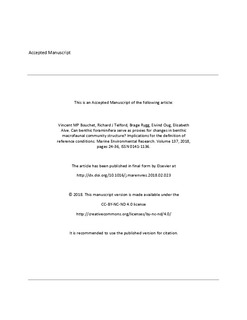| dc.contributor.author | Bouchet, Vincent MP | |
| dc.contributor.author | Telford, Richard J | |
| dc.contributor.author | Rygg, Brage | |
| dc.contributor.author | Oug, Eivind | |
| dc.contributor.author | Alve, Elisabeth | |
| dc.date.accessioned | 2019-06-27T08:37:06Z | |
| dc.date.available | 2019-06-27T08:37:06Z | |
| dc.date.created | 2018-06-12T21:27:44Z | |
| dc.date.issued | 2018 | |
| dc.identifier.citation | Marine Environmental Research. 2018, 137, 24-36. | nb_NO |
| dc.identifier.issn | 0141-1136 | |
| dc.identifier.uri | http://hdl.handle.net/11250/2602481 | |
| dc.description | Embargo until 22 February 2020 | nb_NO |
| dc.description.abstract | Benthic macrofauna is one of the most widely used biological groups to assess the ecological status of marine systems. Lately, attention has been paid to similar use of benthic foraminifera. In this study, distribution patterns of benthic foraminiferal and macrofaunal species were investigated simultaneously in 11 fjords in southeastern Norway in order to assess correlations and responses to environmental conditions. Selected fjords allowed to investigate contrasted environmental conditions from low total organic carbon (TOC) content (sediment TOC < 2.7%) in normoxia (bottom-water [O2] > 2 mL O2.L−1) up to high TOC content (> 3.4%) in severe hypoxia (< 0.5 mL O2.L−1). Environmental parameters comprised bottom-water dissolved oxygen, grain size, total organic carbon, total nitrogen (TN), pigments and depth below threshold (DBT). Foraminiferal and macrofaunal community data were significantly correlated (Procrustes analysis m2 = 0.66, p = 0.001). Hence, benthic foraminiferal distribution patterns mirror those of benthic macrofauna. However, as opposed to the foraminifera, macrofauna was not recorded at the most oxygen-depleted stations and, hence, was more sensitive to severe oxygen depletion. With regard to assigning species to ecological groups for ecological quality status assessment, the results suggest that species, e.g. Spiroplectammina biformis (foraminifera), Scalibregma inflatum (macrofauna), may exhibit different ecological requirements depending on their habitat. Considering the observed congruent patterns of benthic foraminifera and macrofauna, palaeo-communities of benthic foraminifera could be used as indicators of reference conditions for benthic macrofaunal community structure. This would however need further developments of algorithms to perform such a translation. | nb_NO |
| dc.language.iso | eng | nb_NO |
| dc.publisher | Elsevier | nb_NO |
| dc.rights | Attribution-NonCommercial-NoDerivatives 4.0 Internasjonal | * |
| dc.rights.uri | http://creativecommons.org/licenses/by-nc-nd/4.0/deed.no | * |
| dc.title | Can benthic foraminifera serve as proxies for changes in benthic macrofaunal community structure? Implications for the definition of reference conditions | nb_NO |
| dc.type | Journal article | nb_NO |
| dc.type | Peer reviewed | nb_NO |
| dc.description.version | acceptedVersion | nb_NO |
| dc.source.pagenumber | 24-36 | nb_NO |
| dc.source.volume | 137 | nb_NO |
| dc.source.journal | Marine Environmental Research | nb_NO |
| dc.identifier.doi | 10.1016/j.marenvres.2018.02.023 | |
| dc.identifier.cristin | 1590841 | |
| dc.relation.project | Norges forskningsråd: 184870 | nb_NO |
| cristin.unitcode | 7464,20,11,0 | |
| cristin.unitname | Marin biologi | |
| cristin.ispublished | true | |
| cristin.fulltext | original | |
| cristin.fulltext | postprint | |
| cristin.qualitycode | 2 | |

